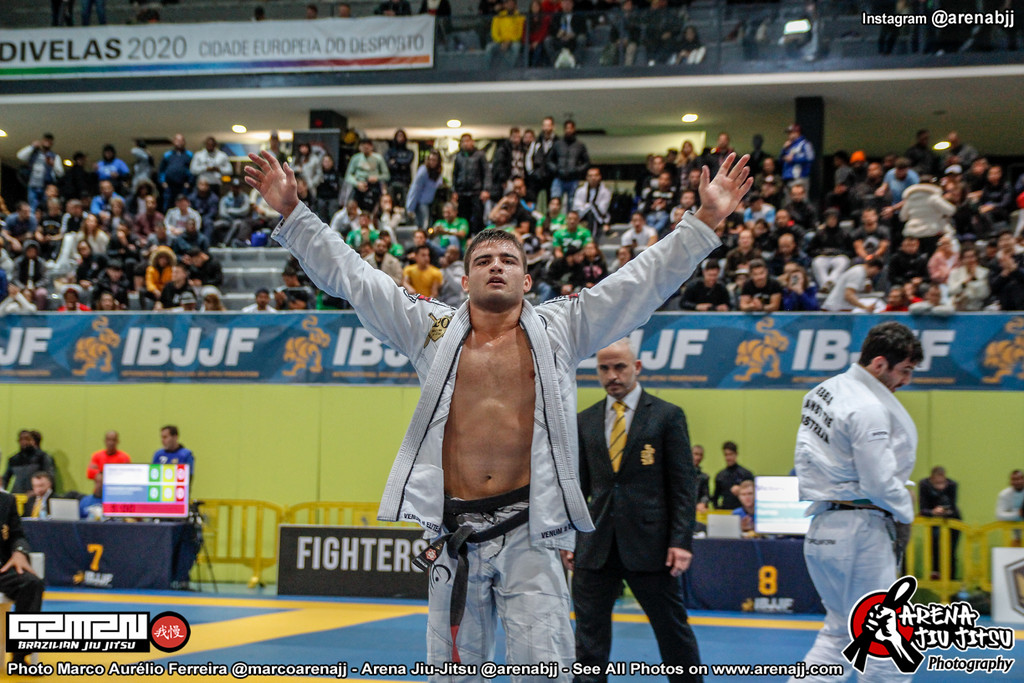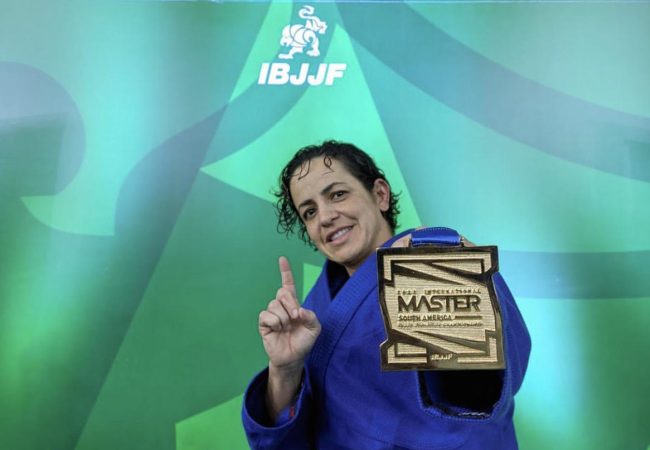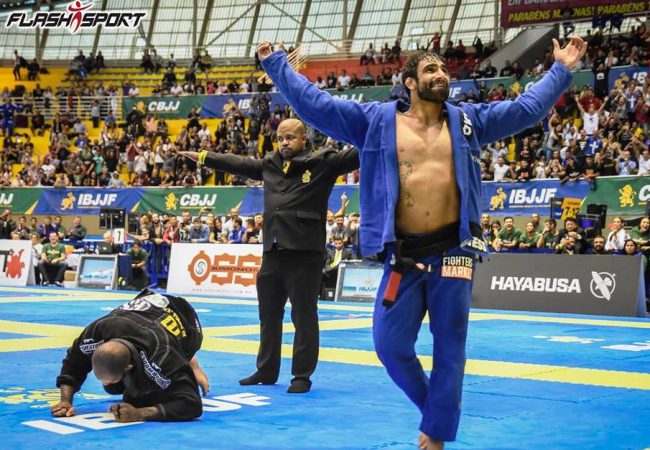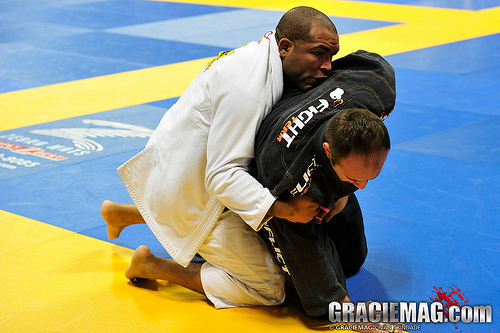Black-belt Gustavo Batista, 22, seems to have no time to waste. One sign of this came after his triumph at the 2019 European Jiu-Jitsu Championship in January. The Atos star read the questions sent over the phone, reflected and answered beautifully — in just over an hour.
As an athlete, Batista doesn’t waste time either. He was a blue-belt world champion in 2015 — and in 2018 he was already repeating the feat with the black belt around his waist.
In editions of the Euros, he is usually even “luckier”: Gustavo has won every time he fought in Portugal. He got double gold at blue (’15), purple (’16), brown (’17) and now black. He also became one of the youngest fighters to win the Euros’ absolute division — losing by a few months to Rodolfo Vieira, who won in 2012 aged 22 years and four months. But Batista can claim to have beaten Roger Gracie’s mark of 24 years, from 2005.
More recently, at the Los Angeles BJJ Pro, Gustavo succeeded in the heavyweight division as he bested Fellipe Trovo to win a 4,000-dollar check, his engine already revving up for this year’s Pan. Graciemag talked to the Santa Catarina native to try to extract his recipe for becoming a victorious fighter. Here’s what we got out of him.
GRACIEMAG: After the Euros, another title at the BJJ Pro. What did you learn from the competition?
GUSTAVO BATISTA: I always like to keep myself active, competing. I fought in the IBJJF’s Los Angeles BJJ Pro to keep up the pace, but also for the prize money. I managed to work on all that I’ve been practicing — my guard, passes, and also taking down, which is a part of what I’ve been learning here training at Atos.
You are living in San Diego, Calif. You were born in Palhoça, moved to São Paulo, and have ended up in the U.S. Was it a big adventure until cementing yourself as a champion?
I’ve always sought to reach the next level, and in BJJ this evolution requires us not to waste time if we want to evolve as a competitor. I trained in my town until I was a blue-belt, and there I noticed I needed more competition-focused training. That’s when I went to São Paulo, where I evolved a good deal and became a black-belt. Then came the time to take another step in my career, looking for greater professionalization. Difficulties abounded: criticism, financial troubles, bad living conditions, lack of sponsors. But I knew that all of those complications would be temporary. Thank God everything went as planned, life got better, and the titles are coming. It was very much worth it.
What exactly were you looking for moving from NS Brotherhood to Atos? And did you find it?
I was looking for more teamwork, support for my career and the vision of a teacher like André Galvão, who is a very experienced athlete, renowned and an exemplary leader. To sum it up, I was looking for greater professionalization. And I found it, yes.
Who inspires you when you fight?
From my start I was always inspired by Rodolfo Vieira (GFTeam). I also really like the jiu-jitsu of my teacher André Galvão and Lucas Lepri (Alliance) — they are the three guys I would watch most in videos. I think my top game resembles Lucas’s a bit, in fact.
So you had it all mapped out before the Euros’ absolute final…
[Laughs.] Yes. Thanks to that, I knew his game deeply, which helped me.
You beat Lepri 10-0. What was the decisive play?
I actually believe it was the start, when I called him to my guard already managing to perform the sweep. It was a decisive factor in the final; after all, I managed to open a 2-0 score against an experienced, technical guy, and getting on top to boot. It was an important win against a great athlete, but it’s in the past. Now it’s about keeping up the work and thinking about my new objectives.
You have won every European Championship you fought in, from blue to black. Is there a recipe for this?
I don’t know. What I seek is to keep myself training year ‘round. I keep my constancy of training for the whole season, even at the end of the year — after all, the European is in January. A recipe that has been working for me is to recharge my batteries in my hometown in December. I always travel there and count on the help of my old friends for training, and on my mom’s food, which works miracles. [Laughs.] My mind seeks to always evolve and learn new things to improve my jiu-jitsu — I think the recipe to efficient jiu-jitsu is constant evolution. We can’t stop learning.
When we saw you win the 2015 Worlds in Long Beach at blue, your pressure was something to behold. Do you think your style has changed much since?
It has a little. I believe I already had a solid game for the blue belt, because I always sought to extract the most knowledge out of my higher-ranked partners around me.
Tell us a good story from the time you used to train with the Miyaos, who this year also swept the competition at the Euros.
I don’t know whether I have a good story, but I have good memories. There was even one time we trained so much we got sick. [Laughs.] They really train a lot and are very disciplined. I learned lots of things from Paulo and João, two guys who helped me evolve a bunch in those days. They are examples as athletes and people.
Your sweeps and your pressure from the top seem very even. How does one train to achieve that?
I try to challenge myself in my training. For example, if you feel better on top, you have to challenge yourself and play guard. And vice versa. Without fear of having a bad time. It’s important to practice your difficulty because that can and will happen in competition. And there’s an interesting point in this: when the goal of your training is to improve your difficulties, you consequently gain in motivation, because you start training with more desire to solve that problem, correct the flaw.
What does your training look like today?
Training sessions with Prof. Galvão are pretty varied: I do some drills, specific training and plenty of rolls too. The training session always has a different format, and also quite challenging. Three times a week I do very specific physical preparation for BJJ. On average I train four to five hours daily; depends on the day.
What have you learned about competition from Luiza, your girlfriend?
I have learned a lot. Luiza is more experienced than me at black belt and imparts a lot of what she’s been through on the mats, good and bad — all that she’s been through in training and competition. This helps me a lot.
You hit a bit of a wall in World Championships at purple and brown, right? What did you learn there?
Yes, the losses suck, but they helped me keep my thirst of wanting to improve each time until I got the black belt. Since the blue belt, I’ve always trained thinking of evolving to the max, and I learned that the colored belts are important to acquire experiences, good and bad, for the big time. The lesson is that we can’t get shaken up with defeats at the start of our career, because it’s when we reach the black belt that everything really matters.





